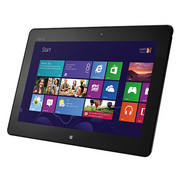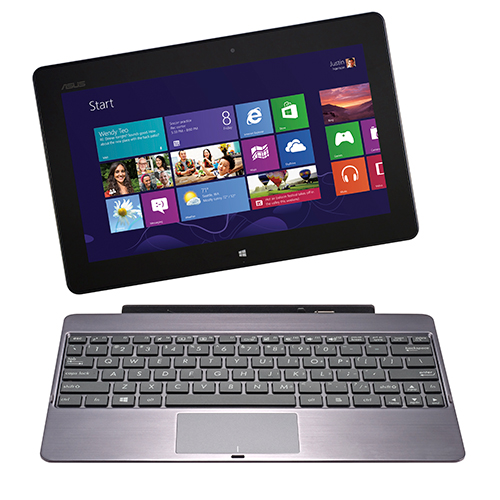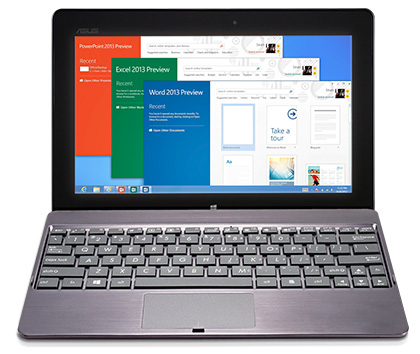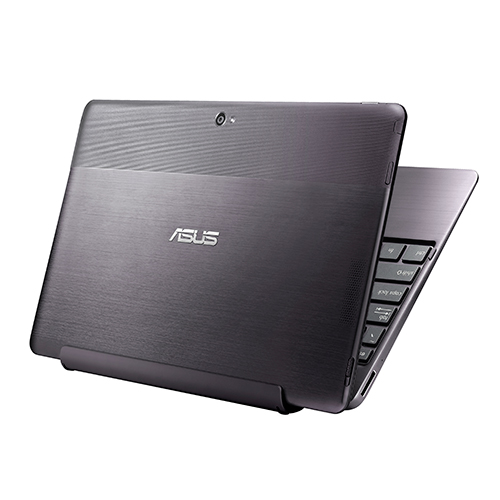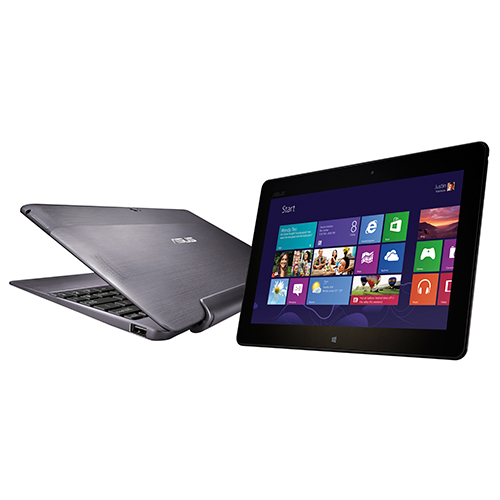Asus Vivo Tab RT TF600
Ausstattung / Datenblatt
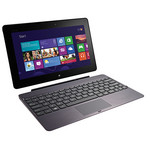
Preisvergleich
Durchschnitt von 6 Bewertungen (aus 5 Tests)
Testberichte für das Asus Vivo Tab RT TF600
Der Kampf beginnt. Mit dem Surface RT wurde der Grundstein für das neue Windows RT gelegt und nun buhlen die Hersteller um die Gunst des Käufers. Kann die ausgiebige Erfahrung als Tablet-Produzent Asus den entscheidenden Vorteil gegenüber der Konkurrenz verschaffen?
Quelle: PC Pro
 EN→DE Archive.org version
EN→DE Archive.org versionUltimately, Asus’ VivoTab RT gets the hardware side of things almost spot on: it’s gorgeous, lightweight and beautifully designed. But until the software starts to deliver on its promises, lovely hardware just isn't enough.
Einzeltest, online verfügbar, Kurz, Datum: 18.01.2013
Bewertung: Gesamt: 67% Preis: 50% Leistung: 83% Ausstattung: 83% Gehäuse: 83%
Quelle: Tech Advisor
 EN→DE Archive.org version
EN→DE Archive.org versionTablets are all about the experience of software married to hardware. The Asus Vivo Tab's solid hardware provides the makings of a good experience, and Windows RT is a good foundation for that experience. But Windows RT's many software quirks and omissions may limit the Vivo Tab's audience to dedicated PC users who've recently purchased a Windows 8 laptop or desktop, and want to extend their new Modern UI software purchases across both systems. The inclusion of Office Home & Student 2014 RT gives the Vivi Tab RT an edge, but that edge would have been greater still with a better keyboard dock.
Einzeltest, online verfügbar, Kurz, Datum: 25.10.2012
Bewertung: Gesamt: 70%
Quelle: PC Mag
 EN→DE Archive.org version
EN→DE Archive.org versionThe Asus Vivo Tab RT certainly scores well on battery life, innovation, and portability. Usability, on the other hand, is a mixed bag. It comes with Office RT, a must-have program for workers and students, but the 3,000 app selection from the various apps stores (Windows Store, Asus@Vibe, and Xbox Games) are paltry in comparison to the hundreds of thousands of apps on the iTunes Store, tens of thousands on Google Play, and millions of apps for Windows 7 and 8. Until the Windows Store really gets going, you'll still find a better selection of apps on an iPad or Android tablet. That said, if what you need is a physical keyboard, phenomenal battery life, Microsoft Office, and the Web, the Asus Vivo Tab RT is an intriguing choice.
Einzeltest, online verfügbar, Kurz, Datum: 23.10.2012
Bewertung: Gesamt: 70%
Quelle: PC World
 EN→DE Archive.org version
EN→DE Archive.org versionTablets are all about the experience of software married to hardware. The Asus Vivo Tab's solid hardware provides the makings of a good experience, and Windows RT is a good foundation for that experience. But Windows RT's many software quirks and omissions may limit the Vivo Tab's audience to dedicated PC users who've recently purchased a Windows 8 laptop or desktop, and want to extend their new Modern UI software purchases across both systems. The inclusion of Office Home & Student 2014 RT gives the Vivi Tab RT an edge, but that edge would have been greater still with a better keyboard dock.
Einzeltest, online verfügbar, Mittel, Datum: 23.10.2012
Bewertung: Gesamt: 70%
Quelle: Sohoa VN Express
 VN→DE Archive.org version
VN→DE Archive.org versionEinzeltest, online verfügbar, Kurz, Datum: 15.01.2013
Bewertung: Gesamt: 80% Bildschirm: 80% Mobilität: 90% Gehäuse: 70%
Kommentar
NVIDIA GeForce ULP (Tegra 3): Integrierte Ultra Low Power (ULP) GPU im Tegra 3 SoC. Technisch eine optimierte GeForce ULP aus dem Tegra 2 jedoch mit zusätzlichen 4 Pixelshader.
3D Spiele sind auf diesen Vertretern nur in Ausnahmen spielbar, grundsätzlich sind die Grafiklösungen hierfür jedoch nicht geeignet. Office Programme und Internet surfen dürfte jedoch ohne Problem möglich sein.
» Weitere Informationen gibt es in unserem Notebook-Grafikkartenvergleich und der Benchmarkliste.
3: High-End-SoC mit Quad-Core-CPU auf ARM Cortex A9 Basis + Stromspar-Kern, inkl. GeForce-GPU und Nachfolger des Tegra 2. Gefertigt in 40nm.» Weitere Infos gibt es in unserem Prozessorvergleich Vergleich mobiler Prozessoren und der Prozessoren Benchmarkliste .
10.10": Dies ist ein Standardanzeigeformat für Tablet-Computer oder kleine Convertibles. Man sieht mehr auf diesem Bildschirm als auf einem kleinen Smartphone. Große Auflösungen darf man aber nicht erwarten. Auf der anderen Seite ist die Mobilität kein Problem.» Prüfen Sie in unserer DPI Liste, welche Displays wie fein aufgelöst sind.
0.525 kg:
In diesem Gewichtsbereich liegen ein paar schwere Smartphones und vor allem Tablets.
Asus: ASUSTeK Computer Inc. ist ein großer taiwanesischer Hersteller von Computer-Hardware mit Sitz in Taipeh, gegründet 1989. Unter dem Markennamen Asus fertigt das Unternehmen eine breite Palette von Produkten, darunter Laptops, Desktops, Motherboards, Grafikkarten, Monitore, Smartphones und Netzwerkgeräte, Komplettsysteme und PC-Bauteile für Endkunden.
Unter dem Markennamen ROG (Republic of Gamers) stellt ASUS Gaming-Laptops her, die bei Spielern für ihre leistungsstarken Spezifikationen, dedizierten Grafikkarten, Displays mit hoher Bildwiederholrate und fortschrittlichen Kühlsystemen bekannt sind.
Über das Gaming hinaus werden eine breite Palette von Notebooks für unterschiedliche Anforderungen und Budgets geboten: von ultraschlanken und leichten Ultrabooks bis hin zu vielseitigen 2-in-1-Convertibles und budgetfreundlichen Optionen. 2023 hatte Asus einen Weltmarktanteil von 7% am PC-Markts.
Die Kundenzufriedenheit mit ASUS-Notebooks betrifft Leistung, die Funktionen und das gute Preis-Leistungs-Verhältnis der ASUS-Notebooks. Wie bei jeder Marke gibt es jedoch gelegentlich Berichte über Probleme wie Überhitzung, Treiberkompatibilität oder Probleme mit der Verarbeitungsqualität.
74.33%: Diese Bewertung ist schlecht. Locker drei Viertel der Modelle werden besser beurteilt. Das ist eher keine Kaufempfehlung. Auch wenn Verbalbewertungen in diesem Bereich gar nicht so schlecht klingen ("genügend" oder "befriedigend"), meist sind es Euphemismen, die eine Klassifikation als unterdurchschnittliches Notebook verschleiern.
» Lesen Sie auch unsere Notebook-Kaufberatung.


 Deutsch
Deutsch English
English Español
Español Français
Français Italiano
Italiano Nederlands
Nederlands Polski
Polski Português
Português Русский
Русский Türkçe
Türkçe Svenska
Svenska Chinese
Chinese Magyar
Magyar